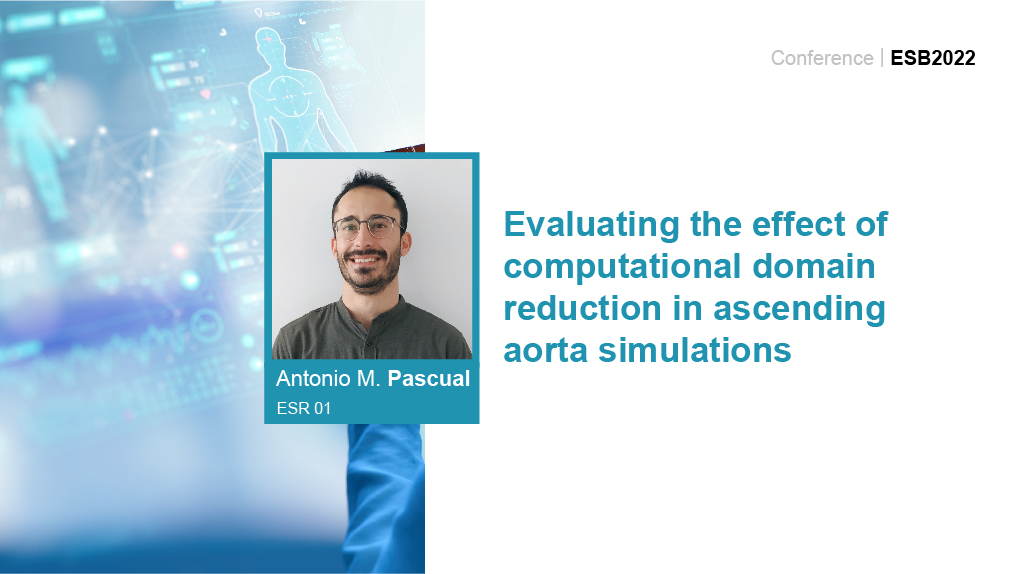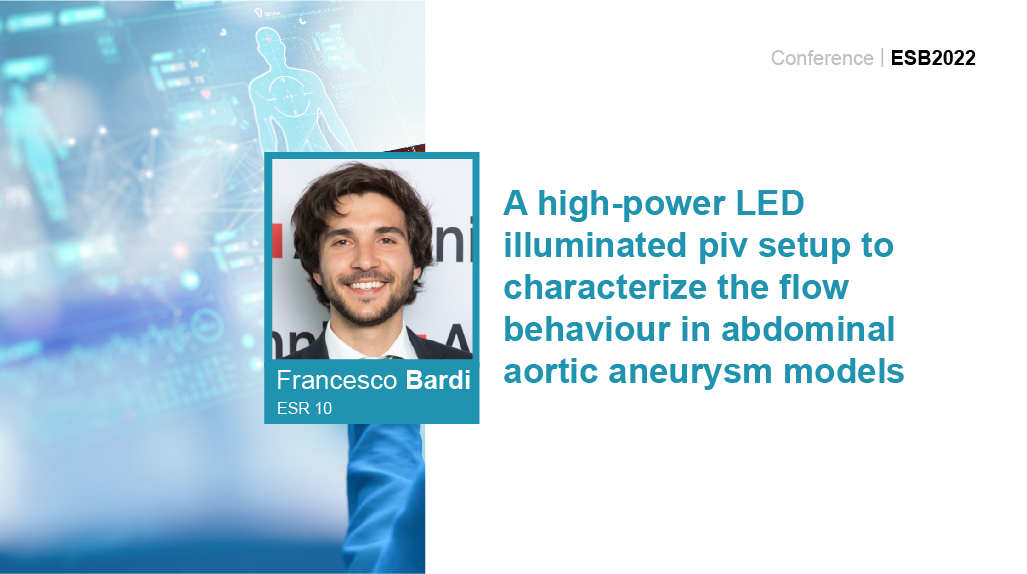Great participation of the MeDiTATe project in the ESBiomech 2022 congress








The MeDiTATe project will be participating in the ESB 2022, the 27th Congress of the European Society of Biomechanics. The event will take place from June 26th to 29th in Porto, Portugal. In this occasion several Early Stage Researchers will be presenting the results of their activities. Here’s the complete list of the participants with their work.
ESR 01, Antonio Martinez Pascual: Evaluating the effect of computational domain reduction in ascending aorta simulations.
Novel diagnostic techniques are arising by enhancing the diagnosis of cardiovascular diseases with the insight given by simulation. However, it is often difficult to adapt these advances into everyday clinical-routine as data needed to personalize the models is often missing, or incomplete. In this study, the effect of reducing the computational domain for ascending thoracic aortic aneurysm (ATAA) simulations by eliminating the arch and descending sections is assessed. The ultimate goal is to understand the requirements for fast and efficient patient-specific modeling, in order to develop appropriate workflows focused on solving real clinical needs.
ESR 02, Leonardo Geronzi: Calibration of the mechanical boundary conditions of a thoracic aorta model including the heart motion effect. In this study, an accurate patient-specific computational model of the thoracic aorta is presented and a new procedure for optimising the visco-elastic structural supports reproducing the interaction of the aorta with the spine and the soft tissue is proposed. The model allows for the inclusion of the heart motion applied at the level of the annulus and is validated by using the available MRI sequences of the vessel.
ESR 09, Martino Andrea Scarpolini: A non rigid registration algorithm to build statistical shape model of thoracic aorta, together with aortic arch and supra aortic vessels. In this work we present a novel non rigid registration algorithm specifically designed for vessel-like structures. The application of this algorithm to the human thoracic aorta allowed us to build a surface-based Statistical Shape Model (SSM) of the ascending and descending aorta, together with the arch and supra aortic vessels. Computational Fluid Dynamic (CFD) features are computed and a correlation study is performed with respect to the anatomical features extracted through the SSM.
ESR 10, Francesco Bardi: A high-power LED illuminated PIV setup to characterize the flow behaviour in abdominal aortic aneurysm models. Experimental circulatory loops are acquiring an increasing importance, given their possibility to be used as tools to deepen the knowledge of cardiovascular pathologies. In the context of in-vitro hemodynamics, Particle Image Velocimetry (PIV) is a well-established technique to measure the spatial and temporal evolution of the velocity and the Wall Shear Stress (WSS) inside anatomical phantoms. In this work a cost-effective setup to perform 2D PIV studies of large blood vessels has been evaluated. We found that the system can be used to measure the instantaneous velocity field for a region of interest of 25 mm x 50 mm.
ESR 11, Monica Emendi: Prediction of guidewire induced aortic deformations during EVAR: FEA and in vitro study. In this work, the insertion of a super-stiff guidewire in patient-specific aneurysmatic abdominal aortas has been simulated through finite element analysis and experimentally validated in the hybrid operating room using additive manufactured models. The aim of the study is to obtain a prediction of the guidewire’s path and aortic deformations during EVAR to improve the pre-operative planning and intra-operative navigation, going towards a radiation and contrast-free procedure.
ESR 13, Marta Bracco: AAA mechanics during ultrasound procedures. The presented work analyses the effects of the ultrasound probe pressure in abdominal aortic aneurysms. Clinical abdominal ultrasound procedures require the operator to apply a pressure on the patient abdomen. The entity of this pressure is rarely reported because it is supposed to have a minimal impact to the current measurements, namely the maximum anteroposterior diameter. However, pressure applied could potentially cause significant bias in non-invasive biomechanical characterizations. In order to test this hypothesis, patient-specific finite element simulations are performed in the case of zero, light and firm pressure.
ESR 14, Maria Nicole Antonuccio: Color-Doppler based hemodynamics of aortic phantoms. This work shows examples of velocity vector fields reconstruction using Color-Doppler images acquired on aortic phantoms. Patient-specificphantoms of healthy and pathological aortas were manufactured in rigid and deformable materials and used to acquire Doppler cineloops. Combining 3D printing and the velocity reconstruction from Color-Doppler data is promising as it also allows to investigate a variety of geometries and flow conditions, characterizing the vessel hemodynamics and eventually complementing vascular diseases diagnosis.
